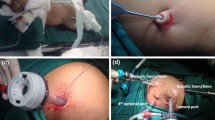Abstract
Background
Initial results in pediatric surgery are encouraging, particularly in the field of pediatric urology. However, there is limited experience with its application in infants and neonates. The aim of this study was to compare the feasibility and safety of robotic-assisted surgery in two populations of children, one weighing less and one weighing more than 15.0 kg.
Methods
A multicentric study was performed comparing the success of robotic-assisted surgery in patients who weighed less than 15.0 kg (group A) to patients heavier than 15.0 kg (group B), with a total of 178 procedures performed between January 2008 and December 2012. Data concerning the perioperative and intraoperative periods were prospectively collected and retrospectively analyzed.
Results
The success of robotic-assisted surgery was compared between group A (62 patients, 11.1 kg) and group B (116 patients, 30.2 kg), with a mean follow-up of 37 months (16–75 months). The conversion rate was superior for group A (5 vs. 2 %) and involved three neonatal thoracic procedures. Focusing on three common procedures for both groups (pyeloplasty, partial nephrectomy, and fundoplication), the amount of time for set up was longer for group A (p < 0.05). We found no statistical differences in the mean total operative time and length of hospital stay. The postoperative follow-up revealed similar results for both groups.
Conclusions
Cautious adjustments in the patient positioning and trocar placement were necessary in a subset of this pediatric population. For these three particular procedures, with the exception of the longer set up time, the results between the two groups were comparable. These data support the feasibility of robotic-assisted surgery for small children, despite the lack of dedicated instruments.



Similar content being viewed by others
References
van Haasteren G, Levine S, Hayes W (2009) Pediatric robotic surgery: early assessment. Pediatrics 124:1642–1649
Woo R, Le D, Krummel TM, Albanese C (2004) Robot-assisted pediatric surgery. Am J Surg 188:27S–37S
Cundy TP, Shetty K, Clark J, Chang TP, Sriskandarajah K, Gattas NE, Najmaldin A, Yang GZ, Darzi A (2013) The first decade of robotic surgery in children. J Pediatr Surg 48:858–865
Orvieto MA, Large M, Gundeti MS (2012) Robotic paediatric urology. BJU Int 110:2–13
Chaussy Y, Becmeur F, Lardy H, Aubert D (2013) Robot-assisted surgery: current status evaluation in abdominal and urological pediatric surgery. J Laparoendosc Adv Surg Technol A 23:530–538
Sorensen MD, Johnson MH, Delostrinos C, Bice JB, Grady RW, Lendvay TS (2010) Initiation of a pediatric robotic surgery program: institutional challenges and realistic outcomes. Surg Endosc 24:2803–2808
Bansal D, Defoor W R Jr, Reddy PP, Minevich EA, Noh PH (2013) Complications of robotic surgery in pediatric urology: a single institution experience. Urology 82:917–921
Srougi V, Yorioka M, Sanchez DC, Onal B, Houck CS, Nguyen HT (2013) The feasibility of robotic urologic surgery in infants and toddlers. J Pediatr Urol 9:1198
Meehan JJ (2009) Robotic surgery in small children: is there room for this? J Laparoendosc Adv Surg Technol A 19:707–712
Pelizzo G, Nakib G, Goruppi I, Avolio L, Romano P, Raffaele A, Scorletti F, Mencherini S, Calcaterra V (2014) Pediatric robotic pyeloplasty in patients weighing less than 10 kg initial experience. Surg Laparosc Endosc Percutan Technol 24:e29–e31
Meehan JJ, Sandler A (2008) Pediatric robotic surgery: A single-institutional review of the first 100 consecutive cases. Surg Endosc 22:177–182
Camps JI (2011) The use of robotics in pediatric surgery: my initial experience. Pediatr Surg Int 27:991–996
de Lambert G, Fourcade L, Centi J, Fredon F, Braik K, Szwarc C, Longis B, Lardy H (2013) How to successfully implement a robotic pediatric surgery program: lessons learned after 96 procedures. Surg Endosc 27:2137–2144
Thakre AA, Bailly Y, Sun LW, Van Meer F, Yeung CK (2008) Is smaller workspace a limitation for robot performance in laparoscopy? J Urol 179:1138–1142; discussion 1142–1133
Casale P (2008) Robotic pediatric urology. Expert Rev Med Dev 5:59–64
Casale P (2012) Pediatric urologic robotic surgery-PURS. Robotic urology surgery. Springer, New York, pp 431–436
Kutikov A, Nguyen M, Guzzo T, Canter D, Casale P (2006) Robot assisted pyeloplasty in the infant-lessons learned. J Urol 176:2237–2239; discussion 2239–2240
Tasian GE, Wiebe DJ, Casale P (2013) Learning curve of robotic assisted pyeloplasty for pediatric urology fellows. J Urol 190:1622–1627
Sorensen MD, Delostrinos C, Johnson MH, Grady RW, Lendvay TS (2011) Comparison of the learning curve and outcomes of robotic assisted pediatric pyeloplasty. J Urol 185:2517–2522
Disclosure
Q.Ballouhey, T.Villemagne, J.Cros, C.Scwarc, K.Braik, B.longis, H.Lardy and L.Fourcade have no conflicts of interest or financial ties to disclose.
Author information
Authors and Affiliations
Corresponding author
Rights and permissions
About this article
Cite this article
Ballouhey, Q., Villemagne, T., Cros, J. et al. A comparison of robotic surgery in children weighing above and below 15.0 kg: size does not affect surgery success. Surg Endosc 29, 2643–2650 (2015). https://doi.org/10.1007/s00464-014-3982-z
Received:
Accepted:
Published:
Issue Date:
DOI: https://doi.org/10.1007/s00464-014-3982-z




